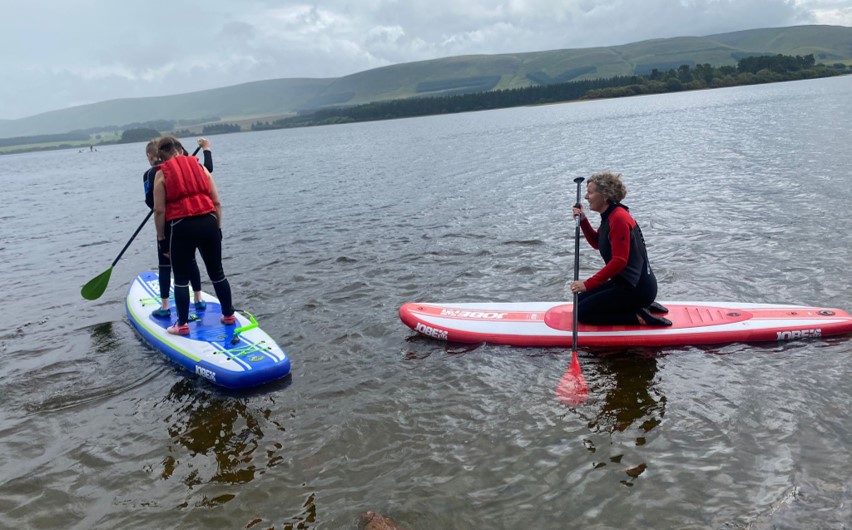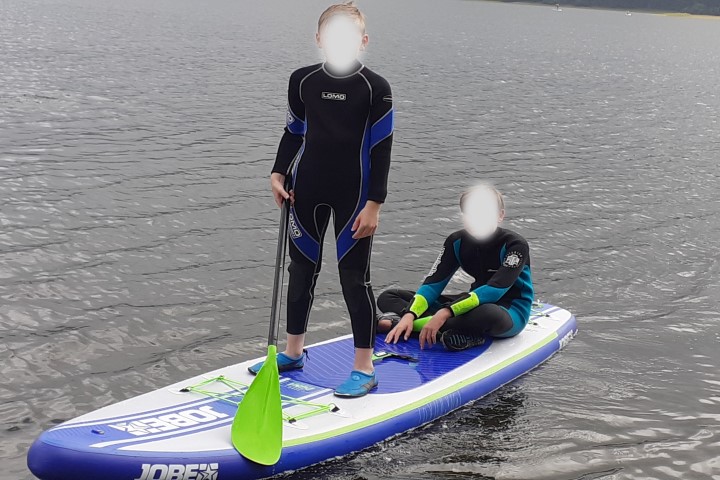After watching exciting videos or perhaps real-life adventure shots of folks with their kids and even dogs happily paddling around the local waterway, maybe you think it’s time you joined in the fun?
And who could blame you! With SUP paddleboarding (Stand Up Paddleboarding) growing massively in popularity (latest stats showing over 3.5 million in the USA in 2019), there is a mad rush to ‘get it on’ and jump aboard the paddleboarding craze.

Why is SUP so popular?
There are a number of reasons why this sport should become as popular as it has done. Here are just some of the reasons why iSUP paddleboarding has become so popular.
- Easy to transport: One of the great advantages of using a paddleboard to explore the local waterways or beaches is the fact that the inflatable boards (yes they do come inflatable) can fit easily into the average family car. The ability to ‘pack-up-and-go’ is a great attraction for many outdoor enthusiasts. This compares to having to fit a roof-rack or tow a trailer behind you if you are trying to transport a solid board or a kayak to your chosen destination
- Ease of Use: Paddleboards are relatively easy to use and quick to master. After only a couple of lessons on how to stand up on the board for instance, a user can soon be away on there first paddleboard adventure.
- Many Different Uses: The versatility of paddleboards means that many different groups are able to incorporate them into their activities. This includes hunting, fishing, yoga & meditation classes, waterway explorers, snorkelling, diving and family groups – even weddings have been performed on paddleboards!
- Staycations: The rise of the covid 19 virus and the stay-at-home ‘staycations’ has led to a subsequent demand for outdoor activities such as paddleboarding.
- SUP Vision: Unlike the kayak or canoe, SUP paddleboarding means that you are in a standing position (obviously!). The often-underrated result of this standing position is that you have a clear and further view of what exactly is surrounding you. I find that this leads it to being an excellent vacation experience where I can really soak in my surroundings and become one with nature.
So with all these exciting ventures ready for the paddleboard enthusiast, do I have any tips for the beginner? Yes indeed! Check out these beginner SUP tips and be best prepared for your paddleboarding experience.
Ten Top SUP Tips To Get You Started:
- Equipment: This is advice I always give my friends in the building trade. When it comes to equipment always do your due diligence, and always buy the best that you can afford! Maybe you cannot afford the very best – that’s ok. Just try to get your hands on the best within your budget – it will pay you back many times over in the future. This is especially so with safety equipment such as buoyancy vests and flotation devices for obvious reasons!
- Learn from a pro: If you have never tried paddleboarding before, then go with someone experienced to ‘show you the ropes’ or why not get a lesson or 2 from a professional? Generally they are not expensive and a good teacher will have you paddleboarding like a pro in no time. In Scotland where I live a great outdoors group to deal with is called Driftwood Adventures who offer many different types of outdoor courses for all levels of experience. You can check them out here
 . And no – I’m NOT affiliated with them!
. And no – I’m NOT affiliated with them! - Putting your board in the water: Make sure that the water is deep enough so that you do not damage the rear fin. 18 inches (450mm) is usually deep enough for this. Carry to the waters edge using the carrying strap, then gently place the front half in the water first and ease in the rest of the board – making sure the rear fin in not obstructed and well clear of the bottom.
- Start by kneeling down: Place your oar across the front of the board, then take a kneeling position on the board first of all to secure your balance, and launch away. Only when you are confident of your balance can you begin to practice the standing position.
- Getting onboard after a fall: Simply aim for the center of the board then pull yourself up by grasping the opposite side. Push yourself back to a kneeling position with the paddle across the front and regain your balance before starting up again.
- Safety First: Quite apart from your buoyancy jackets or belts, you also want to keep your paddleboard tethered to your ankle with a quick or easy release tether. The last thing you want to experience is falling into the water and watching your board drift away from you in the wind or currents! Also mobile phones can be a real life-saver – but only if they do not fall into the water or otherwise get soaked and inoperable. Keep your mobile tethered around your neck or waist in a waterproof bag for safety.
- Monitor the wind: This is especially the case when paddleboarding in the sea, but sometimes even in large bodies of inland water. Never go out when there is an off-shore wind blowing (the wind is blowing from the shore towards the sea). With an offshore wind blowing you can very quickly find yourself in ‘deep water’ with no way to get back to shore.
- Watch the currents: Rip currents are lanes of water that pull quickly back from the shoreline to the sea and can travel at over 2 feet per second
 and up to 8 feet per second – that’s faster than an Olympic swimmer!
and up to 8 feet per second – that’s faster than an Olympic swimmer! - Wear a wet suit: Whilst this may not be necessary in warmer waters, it is essential in the waters around the UK and the Norther hemisphere in general – unless you are made of tougher stuff than me! Even on warm days the water in reservoirs and deep inland lakes can be exceptionally cold, and falling in can lead to cramps resulting in the inability to swim – need I say more?
- Get a good pump: Pumping up the inflatable paddleboard can be a real workout if the pump is not up to the job. Invest in a good pump and you will find life a lot easier – and have a lot more time to spend in the water as hand pumping a board can easily take 20 minutes or more. Alternatively an electric pump should do it in about ten minutes.

The bottom line is that Paddleboarding is great FUN, and knowing these basics is all about being able to enjoy the experience knowing that you have done your research and are cognisant with the different elements of paddleboarding.
Like any outdoor adventure, but especially water sports where drowning is a ‘real and present danger’, it is always best to consider safety and how best to avoid tragedy – rather than wait for it to happen!
Enjoy your paddleboard. It’s fun for all the family – even the dogs! And I personally recommend it for a great day out to experience nature and all the benefits it has to offer.
Recent Posts
Our latest Paddleboard adventure comes mainly thanks to driftwoodadventures! They kindly arranged the whole thing for us - which is important to us especially, as we were not sure of the...
What Fitness Level Do I Need For Stand Up Paddleboarding (SUP)?
Stand-Up Paddleboarding (SUP) is a fantastic water sport that has grown significantly in popularity in recent years. It's a fun and accessible activity that allows you to enjoy the outdoors and get...